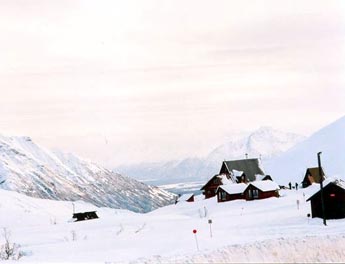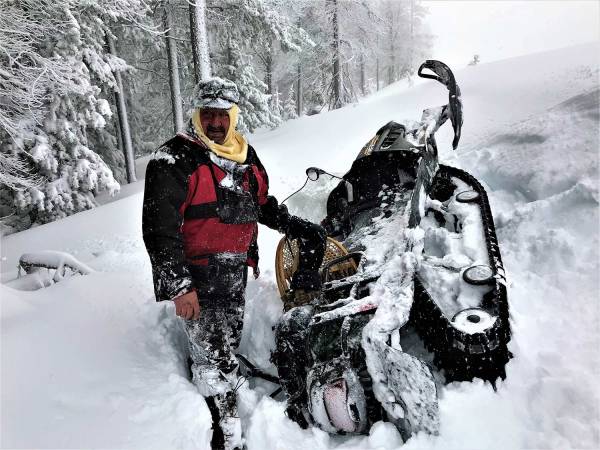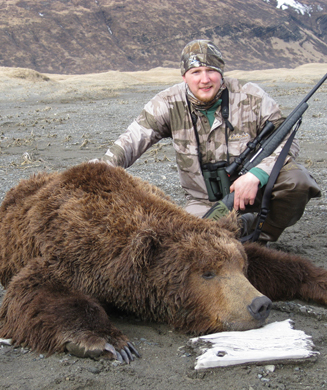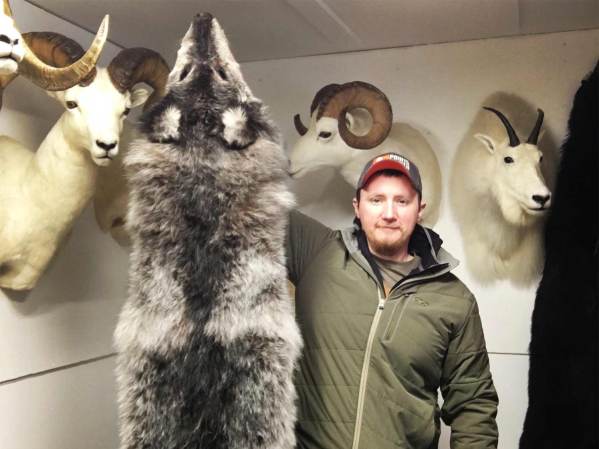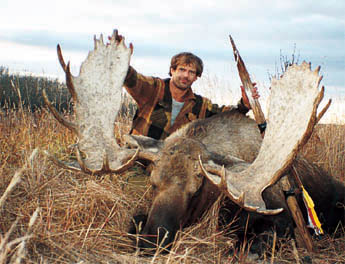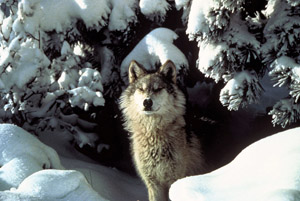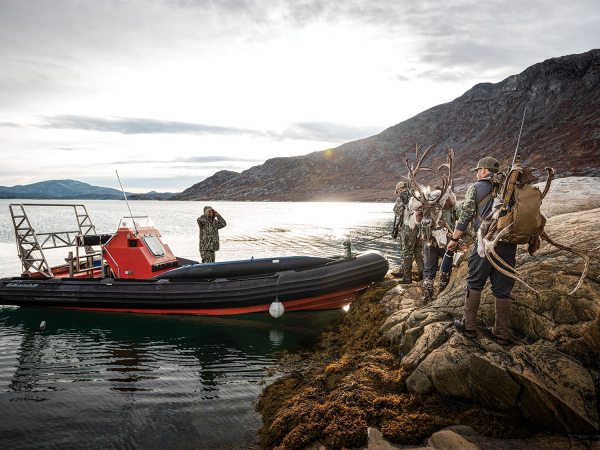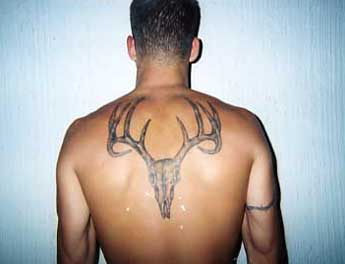The aurora borealis stretches across the northern sky with ribbons of cold, green flame shining through the Alaska night. Countless stars burn bright, their light reflected in the snow around the cabin where Richard Gardner is already up and dressing for work.
Richard is an uncommon man who doesn’t fit society’s mold for success. He never attended college, yet the house he built with his own hands in Delta Junction, Alaska, is paid for in full. At 43, he owns several homesteads, each with an airstrip and cabins he built himself. He can talk electrical engineering yet dresses in a suit of beaver skin, goose down and Carhartt. His profession? Wilderness trapper.
Twenty-four years ago, Richard arrived in Alaska with nothing but a few dollars and a dream to hunt and trap North America’s last frontier. I was one of the first people to help him get started; now I was going to spend a week with him to see how far he had come.
Day One
Richard hugs his kids, kisses his wife, Maureen, and tells her that he loves her before he walks out the door. He doesn’t think about the possibility that he might never see her again when he leaves for work. A wilderness trapline is a hazardous place, and injury or death is ever present. If he fell through the ice on the treacherous Tanana River, there would be no one to save him.
He runs three traplines, each covering 40 to 60 miles. With the end of the season upon him, he’s running only one line now. Set along the Tanana River Flats, it takes five days to work the 60-mile stretch of remote river slough country by snowmobile.
John Gardner, Richard’s brother, neighbor and business partner, is loading the trucks for departure when we arrive. Gas tanks, snowshoes, cables, ropes, waterproof bags, food, tools and sleds are piled into the back of two well-worn pickups. After the trucks are loaded, we drive to the head of a fire trail, where we transfer the gear to snowmobiles for the 10-mile trek to the start of Richard’s trapline. The 17-below-zero temperature and the brisk wind send the chill factor plunging to 32 below.
We don’t go far when John’s snowmobile loses power and dies, the result of a blown track bearing. He always carries spare parts, but not this one. With no other options, John hops on Richard’s sled. They’ll tow John’s machine home on the return trip.
We follow a narrow, two-mile trail that snakes through a forest of birch and spruce and dead-ends at a series of beaver ponds. Natural springs flow year-round, keeping the stream open in some spots and the ice thin in others. The Gardners carefully skirt the edge of the water and set several snares for beaver. Both men are excited about the prospects.
“Hopefully, we’ll have a couple of beavers in a few days,” John says.
We emerge onto a series of willow-lined backwater sloughs. Some are harmless remnants of rivers that once were. Others are winter sirens that lure trappers with the prospect of easy, brush-free travel. “Sloughs are notorious for collecting overflow,” Richard points out. “The sub-zero cold pushes up groundwater, which seeps onto the ice under the insulating layer of snow and keeps it from freezing. It might get worse. Just keep going, no matter what.”
As if on cue, the deep snow around him begins to sink. Richard revs his snowmobile’s engine. John jumps free of the sled and pushes the floundering snowmobile as I try to keep my machine running behind them. The overflow deepens until the icy quicksand sucks both our snowmobiles all the way down to the gears. Richard disconnects his sled. We free his machine and he quickly disappears up the slough to search for another route to the cabin.
[pagebreak] John and I ease into the icy slush. The sled is cold-welded to the overflow and won’t budge. We use snowshoes as shovels, clearing a path through the icy slop that has filled our vapobarrier bunny boots. Slush quickly washes back into the path and begins to harden. John assembles the hand winch, latches a hook to the sled and slogs over to the bank. There, he attaches the cable to some smallish trees, which immediately snap as the winch tightens the cable. Back to work, we tie several ropes together to extend the cable’s reach to larger trees. Ropes stretch and snap in the cold. John doubles up the rope, but we can only winch a few feet of cable before having to retie it. I’m wet to my knees, but try to stay busy removing the slush accumulating ahead of each runner.
We take turns ratcheting the handle an inch at a time, finally extracting the sled and snowmobile 30 feet from the slough onto an elevated bank. We buried the sleds at 1 p.m. It is now 7:30, and Richard hasn’t returned.
My ice-laden snowmobile bogs down repeatedly in the powdery, waist-deep snow, but at least we have it out of the slough. To make our way, we chop a trail through thick willows. In a half hour we only go 20 feet. Meanwhile, the temperature plummets. Ice has frozen to our pants, adding pounds to every step. As John and I discuss building a fire, we spot the headlight of Richard’s struggling snowmobile flickering through the spruce 200 yards away.
His engine revs and bogs down repeatedly as a string of profanity snaps the cold like a whip. Richard finally plunges forward on snowshoes, slashing a swath with his chainsaw through the thick brush. He has just spent hours cutting a trail through the once impenetrable thicket. Finally, we connect.
We are beginning to freeze. Despite the long hours it took Richard to cut his way to us, it takes us only 14 minutes to power back to the cabin.
Once inside, we leap into action. John grabs a hammer and flails away at his overalls, snow and ice calving out of his pant leg. We quickly set the wood-burning stove to a roar as it devours a load of spruce. John presses his iced leg zippers against it, searing his overalls. The ice hisses into vapor as his pants become pliable once again.
Finally down to our long underwear, we’re comfortable in the heat of the cabin. We have a quick dinner of chili and pilot bread before turning in for the night. There are no listeners to Richard’s stories this time. John is already asleep and snoring.
Day Two
At 30 below, the sunrise coats the earth in a meringue of orange hoarfrost so delicate a whisper might shatter it. Unfortunately, some things don’t shatter as easily. A sheath of ice encases the sleds and snowmobiles. After breakfast, Richard walks out and goes to work.
I watch him chisel ice off the pulleys and wheels like a sculptor removing excess stone. My snowmobile won’t start. Richard and John remove their beaver mitts and check the spark plug, then the carburetor. They exchange delicate springs and screws, knowing they have only minutes before their fingers lose sensation. The repairs are made. With three pulls the engine starts.
[pagebreak] The first trap is located on the edge of a frozen creek. Richard’s high-stepped gait through the snow quickens as he nears the first snare. He’s caught a huge river otter. His exuberance shines bright and will help offset the disappointment of empty sets the remainder of the morning. We ride river and woodland trails, checking wolf, fox and otter sets. The stretch of meadow and forest produced some good fur earlier in the season, but today the sets are empty.
At day’s end, we arrive at the second cabin. Icy wind whistles through gaps between the logs. A caribou hide keeps heat from escaping through some damage caused a while back by marauding bears. Floorboards creak and dip where rodents have dug beneath them. Critter droppings litter the shelves like confetti. For trappers finishing a hard day’s work in 20-below temperatures, such primitive accommodations never looked better. Dinner is a simple meal of noodles and sausage.
Day Three
When we wake, the temperature is 23 below…in the cabin. The frames of my glasses burn my temples, and the water bottle under my sleeping bag is filled with ice. My boots have frozen solid.
John crawls toward the stove still in his sleeping bag and builds a fire. Morning grub is two cups of instant oatmeal and coffee. Richard’s breakfast philosophy is simple. “Food must be fast and quick,” he says. “Saves fuel and time. There’s enough work without adding needless kitchen chores.” Water is too precious for washing a cup, so he uses disposable dishes and plates.
The only catch of the day is a fox. With the end of the season upon us, we pull the remainder of the traps and head to the cabin. In the lantern light, Richard skins the fox on his bunk and begins to talk. He tells me about one time when his snowmobile broke down in a blizzard, leaving him with only one chance for survival.
“I huddled by an open campfire, toasting on one side and freezing on the other. I knew what I had to do, and at daybreak, I put on snowshoes and started walking in snow up to my waist. I made the twenty-six miles to my house in under eleven hours,” he says.
Day Four
At this time of year, there is no sunrise, only a gradual lightening of the sky. The all-encompassing fog transforms a massive burn-a desolate stretch of charred, frozen terrain-into a void of wind, air and sound. Birds are conspicuously absent. The snow is trackless.
[pagebreak] Lines of blackened spruce angle in all directions. Richard searches for his emergency camp, consisting of a barrel of provisions, a tent, snares and equipment. It’s proving difficult to find. We venture off the trail and deadfall threatens to impede our progress in every direction. Richard urges caution.
“John and I have had too many close calls where we missed getting impaled by inches. Go slow and be ready to dodge,” he says. He finally locates his metal drum hanging in a charred spruce near the edge of the burn.
Day Five
The morning is spent pulling wolf snares and traps. Wolves can bite through the springs of smaller traps or snap chains with their lunging, so all of the wolf traps have heavy-duty chains with huge-pronged anchors. The brothers have little concern that a wolf could pull itself from their traps. In fact, their strangest catch is also their largest.
“The Army was conducting maneuvers and some tanks were following one of my trails,” Richard recalls. “We were checking traps on foot one day and walked up to a small-unit support vehicle. It was the size of a tank. Seems my trap caught its tread and crippled it.
If one of our sets can stop a tanklike vehicle, it can hold a wolf.”
We stop on a bluff overlooking theinner is a simple meal of noodles and sausage.
Day Three
When we wake, the temperature is 23 below…in the cabin. The frames of my glasses burn my temples, and the water bottle under my sleeping bag is filled with ice. My boots have frozen solid.
John crawls toward the stove still in his sleeping bag and builds a fire. Morning grub is two cups of instant oatmeal and coffee. Richard’s breakfast philosophy is simple. “Food must be fast and quick,” he says. “Saves fuel and time. There’s enough work without adding needless kitchen chores.” Water is too precious for washing a cup, so he uses disposable dishes and plates.
The only catch of the day is a fox. With the end of the season upon us, we pull the remainder of the traps and head to the cabin. In the lantern light, Richard skins the fox on his bunk and begins to talk. He tells me about one time when his snowmobile broke down in a blizzard, leaving him with only one chance for survival.
“I huddled by an open campfire, toasting on one side and freezing on the other. I knew what I had to do, and at daybreak, I put on snowshoes and started walking in snow up to my waist. I made the twenty-six miles to my house in under eleven hours,” he says.
Day Four
At this time of year, there is no sunrise, only a gradual lightening of the sky. The all-encompassing fog transforms a massive burn-a desolate stretch of charred, frozen terrain-into a void of wind, air and sound. Birds are conspicuously absent. The snow is trackless.
[pagebreak] Lines of blackened spruce angle in all directions. Richard searches for his emergency camp, consisting of a barrel of provisions, a tent, snares and equipment. It’s proving difficult to find. We venture off the trail and deadfall threatens to impede our progress in every direction. Richard urges caution.
“John and I have had too many close calls where we missed getting impaled by inches. Go slow and be ready to dodge,” he says. He finally locates his metal drum hanging in a charred spruce near the edge of the burn.
Day Five
The morning is spent pulling wolf snares and traps. Wolves can bite through the springs of smaller traps or snap chains with their lunging, so all of the wolf traps have heavy-duty chains with huge-pronged anchors. The brothers have little concern that a wolf could pull itself from their traps. In fact, their strangest catch is also their largest.
“The Army was conducting maneuvers and some tanks were following one of my trails,” Richard recalls. “We were checking traps on foot one day and walked up to a small-unit support vehicle. It was the size of a tank. Seems my trap caught its tread and crippled it.
If one of our sets can stop a tanklike vehicle, it can hold a wolf.”
We stop on a bluff overlooking the
